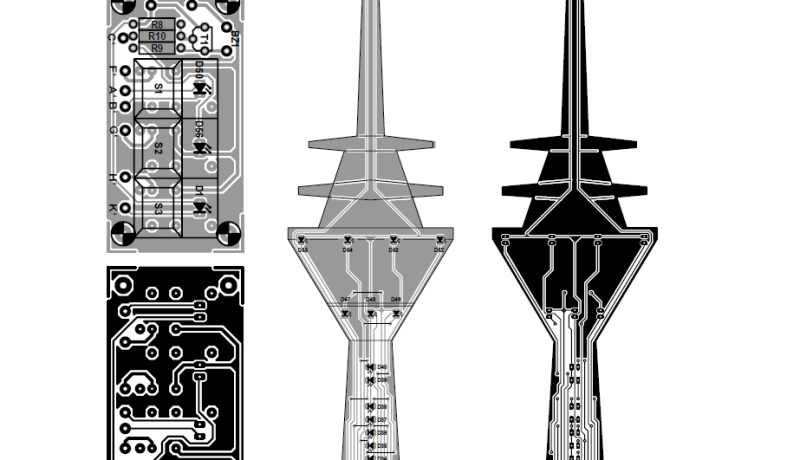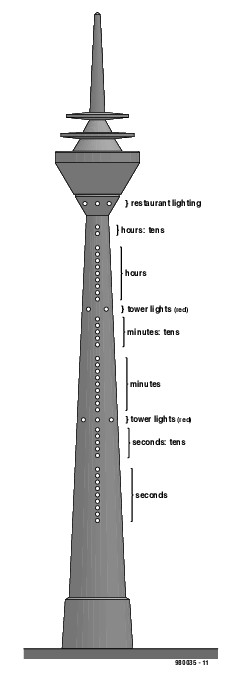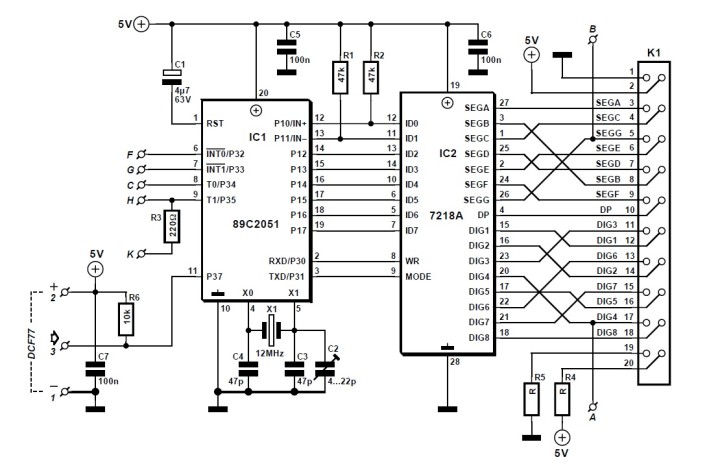Rhine Tower Clock Mk 2
on

Typical for many successful Elektor projects, the Rhine Tower Clock Mk 2 from January 2000 was the result of ripening. Based on his original article in May 1998 called “DCF-Controlled LED Clock”; freelance contributor D. De Mülder spent about two years perfecting the software and defining the outlines of a massive circuit board after the 240.5-meter high (789 ft) Rhine Tower in Düsseldorf. The resulting project was a tall success in Elektor’s publication history and is instantly recognized by many to this day.
From Big Lamps to LEDs
In the Elektor replica, the 39 lamps indicating the time on the real tower were replaced with yellow LEDs, and the restaurant and beacon lights, with red LEDs. The outline of the Rhine Tower can be seen in the drawing in Figure 1, which also shows the coding system used to display the time to bankers and lesser inhabitants of Düsseldorf city and surrounding areas. Contrary to the original Elektor project from 1998, the Rhine Tower Clock Mk2 was also able to work without the reception of the DCF77 time signal transmitter. “DCF77 reception should be possible,” the article said, “within a radius of just under 1000 miles (ca. 1,609 km) from the transmitter location in Mainflingen, Germany. From previous projects employing the DCF77 signal, we know that reception is just about adequate in South-Eastern parts of England, South Scandinavia, and most of Central Europe.” In fact, the most distant DCF77 reception report I got by mail was from a proud lab owner in Ryad. DCF77 transmits Central European Time (CET).

Rhine Tower Clock
showing the time indication
system with lights (or LEDs in the replica).
From 240.5 m to 49 cm
The clock’s intelligence was vested in an 89C2051 microcontroller (Figure 2) running code developed by the author of the project, while the 49-cm-tall PCB readers could buy, was designed under the supervision of Karel Walraven at Elektor Labs.

The PCB consisted of several sections to build the tower base, the control board, a small keyboard, and the tower proper (Figure 3, Elektor’s stunning PCB artwork for the Rhine Tower project. The actual length of the board was 49 cm, as opposed to 240.5 m for the real thing made from concrete and visible in and around Düsseldorf, Germany.). The project firmware wasn’t released at the time, which caused some frustration with Elektor readers having their own programming gear and baulking at Elektor’s “money-grabbing & black-box engineering”. No wonder, illegal copies of “ESS # 996519-1” soon surfaced, especially on ham radio markets. Boos and catcalls too from the UK, Ireland, and Portugal where CET minus 1 hour was required, and no patch supplied by Elektor. On the positive side, the PCB design was printed in the article at 55% of the actual size, permitting the full DIY path to be followed, including “blowing up” the trace layout on a photocopier, followed by certain darkroom activities and then etching, cutting, and drilling!

The Success Factor
Clearly, the success of the RTC Mk2 publication was due to the great software and seeking the limits of functional, aesthetic, PCB design and production for the hobby market in the year 2000. In short, it was all about “Elektorizing” an iconic German tower, bringing the exact time in a visually appealing and challenging way to many e-workplaces, man caves, and the odd living room. No Millennium Bug ever bit this great project but to be honest, that’s mostly thanks to DCF77’s utter reliability and atomic precision.
Questions or Comments?
Do you have technical questions or comments about this article? Email the author at jan.buiting@elektor.com.
About the Author
 Jan Buiting joined Elektor’s English-language editorial team as a Technical Editor in 1985, turning into Editor-in-Chief in 1999. In 2004 Jan launched Retronics, Elektor’s longest-running article series. Although he joined Elektor’s Books & Products team in 2020, Jan has remained a magazine contributor and a consulting specialist. Jan works from home, where he has his own lab geared to vintage electronics test gear and ham radio. In his spare time, he enjoys reading, lecturing, motorcycling, gardening, and hiking.
Jan Buiting joined Elektor’s English-language editorial team as a Technical Editor in 1985, turning into Editor-in-Chief in 1999. In 2004 Jan launched Retronics, Elektor’s longest-running article series. Although he joined Elektor’s Books & Products team in 2020, Jan has remained a magazine contributor and a consulting specialist. Jan works from home, where he has his own lab geared to vintage electronics test gear and ham radio. In his spare time, he enjoys reading, lecturing, motorcycling, gardening, and hiking.



Discussion (2 comments)
pewtu 2 years ago
Built it and still running
TheEditor 2 years ago